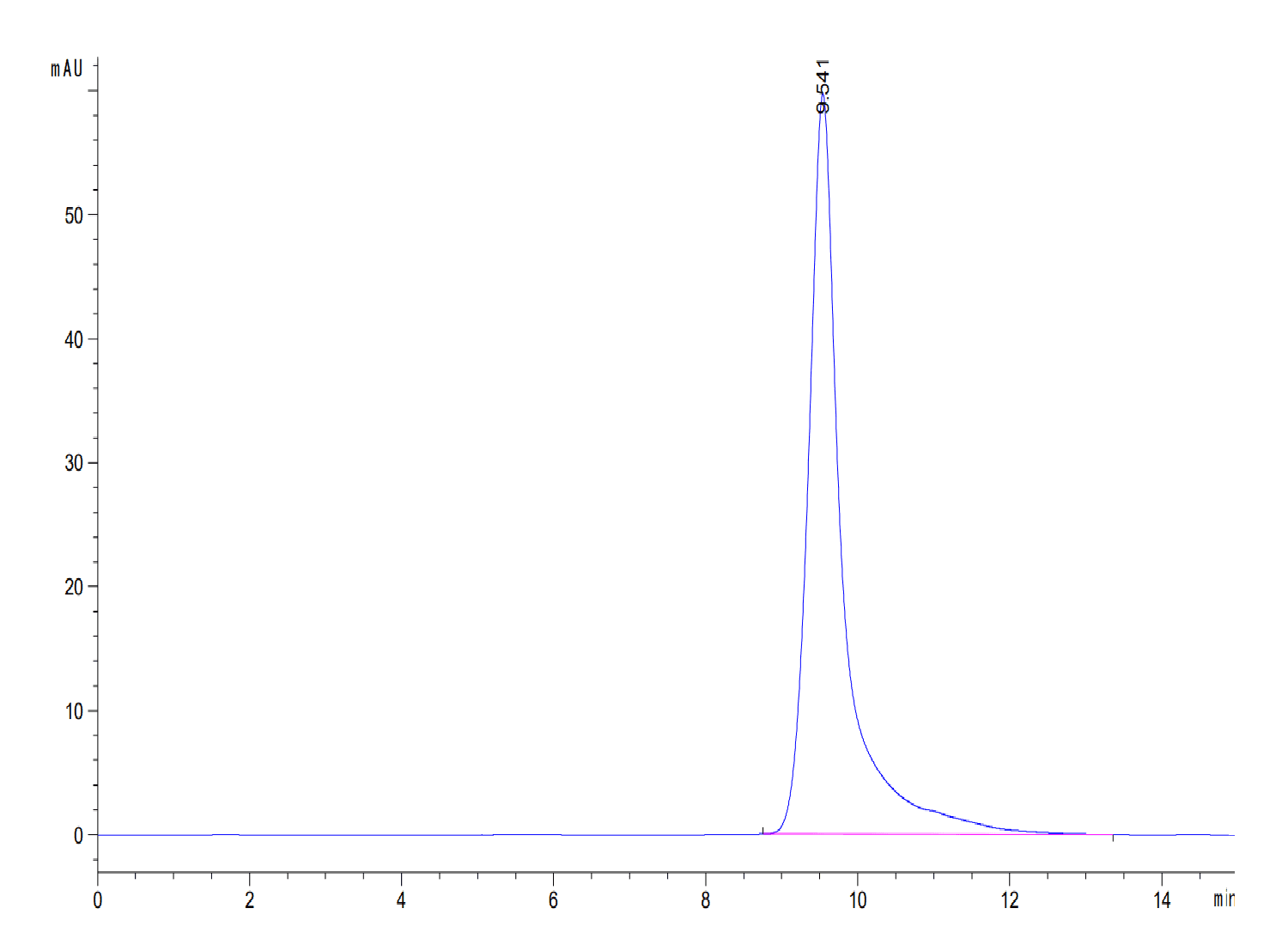| Weight | 1 lbs |
|---|---|
| Dimensions | 9 × 5 × 2 in |
| accession | O14763 |
| express system | HEK293 |
| product tag | C-His-Avi |
| purity | > 95% as determined by Tris-Bis PAGE;> 95% as determined by HPLC |
| background | DR5, also called TRAIL R2, TRICK 2, TNFRSF10B, and MK is a type 1 TNF R superfamily, membrane protein which is a receptor for TRAIL (APO2 ligand). DR5 is a receptor for the cytotoxic ligand TNFSF10/TRAIL. The resulting death-inducing signaling complex (DISC) performs caspase-8 proteolytic activation which initiates the subsequent cascade of caspases (aspartate-specific cysteine proteases) mediating apoptosis. |
| molecular weight | The protein has a predicted MW of 17.2 kDa. Due to glycosylation, the protein migrates to 20-25 kDa based on Tris-Bis PAGE result. |
| available size | 100 µg, 500 µg |
| endotoxin | Less than 1EU per μg by the LAL method. |
Human TRAIL R2/DR5/TNFRSF10B Protein 4651
$218.00 – $725.00
Summary
- Expression: HEK293
- Functional: Yes (ELISA)
- Amino Acid Range: Ile56-Glu182
Human TRAIL R2/DR5/TNFRSF10B Protein 4651
| protein |
|---|
| Size and concentration 100, 500µg and lyophilized |
| Form Lyophilized |
| Storage Instructions Valid for 12 months from date of receipt when stored at -80°C. Recommend to aliquot the protein into smaller quantities for optimal storage. Please minimize freeze-thaw cycles. |
| Storage buffer Shipped at ambient temperature. |
| Purity > 95% as determined by Tris-Bis PAGE |
| target relevance |
|---|
| DR5, also called TRAIL R2, TRICK 2, TNFRSF10B, and MK is a type 1 TNF R superfamily, membrane protein which is a receptor for TRAIL (APO2 ligand). DR5 is a receptor for the cytotoxic ligand TNFSF10/TRAIL. The resulting death-inducing signaling complex (DISC) performs caspase-8 proteolytic activation which initiates the subsequent cascade of caspases (aspartate-specific cysteine proteases) mediating apoptosis. |
| Protein names Tumor necrosis factor receptor superfamily member 10B (Death receptor 5) (TNF-related apoptosis-inducing ligand receptor 2) (TRAIL receptor 2) (TRAIL-R2) (CD antigen CD262) |
| Gene names TNFRSF10B,TNFRSF10B DR5 KILLER TRAILR2 TRICK2 ZTNFR9 UNQ160/PRO186 |
| Mass 47878Da |
| Function Receptor for the cytotoxic ligand TNFSF10/TRAIL (PubMed:10549288). The adapter molecule FADD recruits caspase-8 to the activated receptor. The resulting death-inducing signaling complex (DISC) performs caspase-8 proteolytic activation which initiates the subsequent cascade of caspases (aspartate-specific cysteine proteases) mediating apoptosis. Promotes the activation of NF-kappa-B. Essential for ER stress-induced apoptosis. |
| Subellular location Membrane; Single-pass type I membrane protein. |
| Tissues Widely expressed in adult and fetal tissues; very highly expressed in tumor cell lines such as HeLaS3, K-562, HL-60, SW480, A-549 and G-361; highly expressed in heart, peripheral blood lymphocytes, liver, pancreas, spleen, thymus, prostate, ovary, uterus, placenta, testis, esophagus, stomach and throughout the intestinal tract; not detectable in brain. |
| Structure Monomer (PubMed:10549288). Can interact with TRADD and RIPK1. Interacts with HCMV protein UL141; this interaction prevents TNFRSF10B cell surface expression. Two TNFRSF10B monomers interact with a UL141 homodimer. Three TNFRSF10B molecules interact with TNFSF10 homotrimer (PubMed:10549288). In the absence of stimulation, interacts with BIRC2, DDX3X and GSK3B. The interaction with BIRC2 and DDX3X is further enhanced upon receptor stimulation and accompanied by DDX3X and BIRC2 cleavage (PubMed:18846110). |
| Post-translational modification (Microbial infection) Glycosylated on Arg residue by S.typhimurium protein Ssek3. |
| Domain TOPO_DOM 5 |
| Target Relevance information above includes information from UniProt accession: O14763 |
| The UniProt Consortium |
Data
Publications
Publications
| pmid | title | authors | citation |
|---|---|---|---|
| We haven't added any publications to our database yet. | |||
Protocols
| relevant to this product |
|---|
Documents
| # | ||
|---|---|---|
| Please enter your product and batch number here to retrieve product datasheet, SDS, and QC information. | ||

















